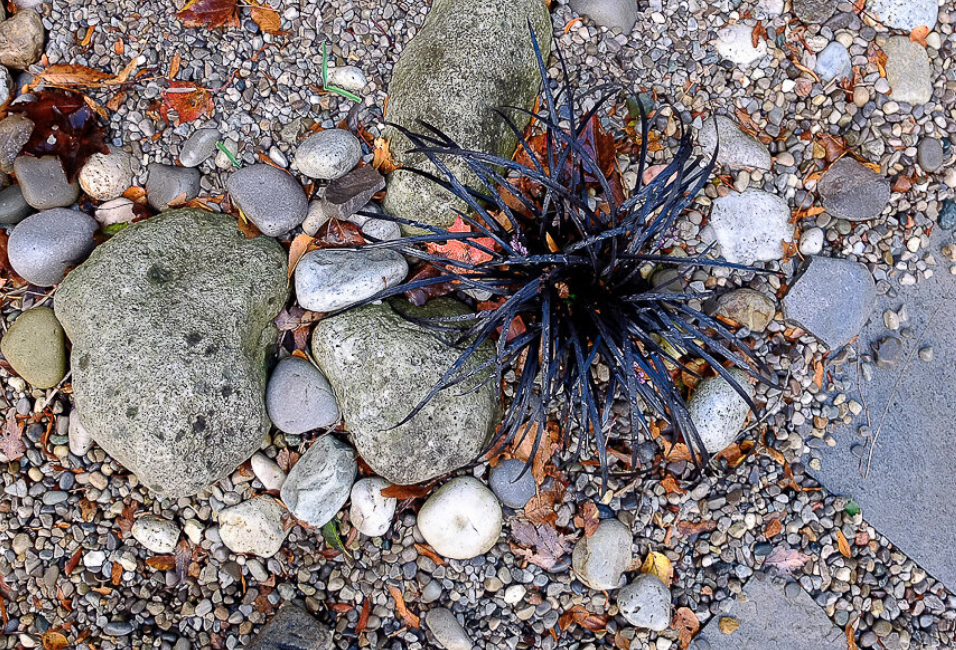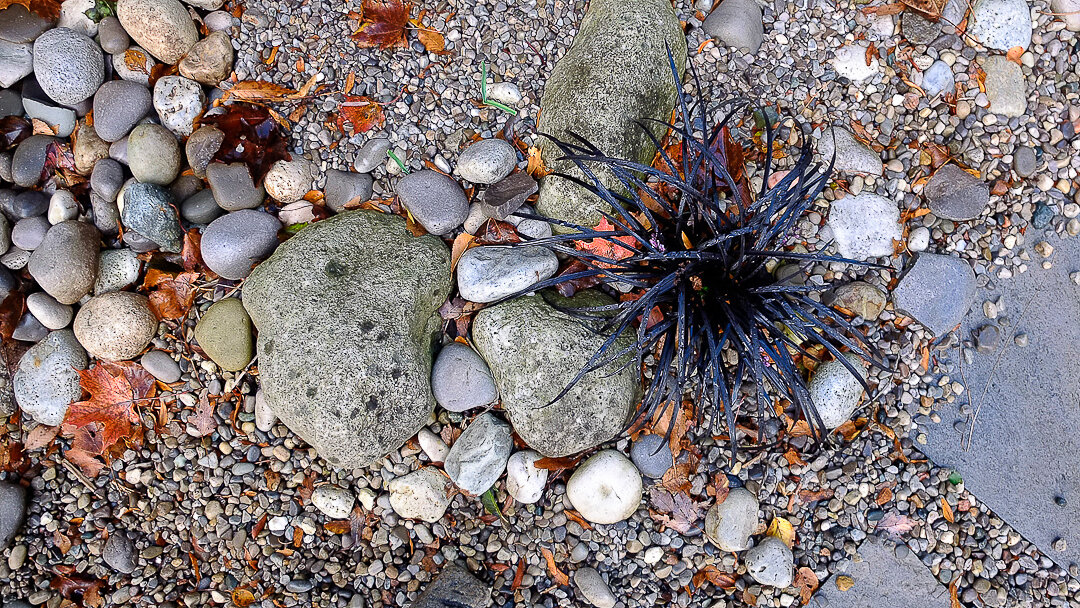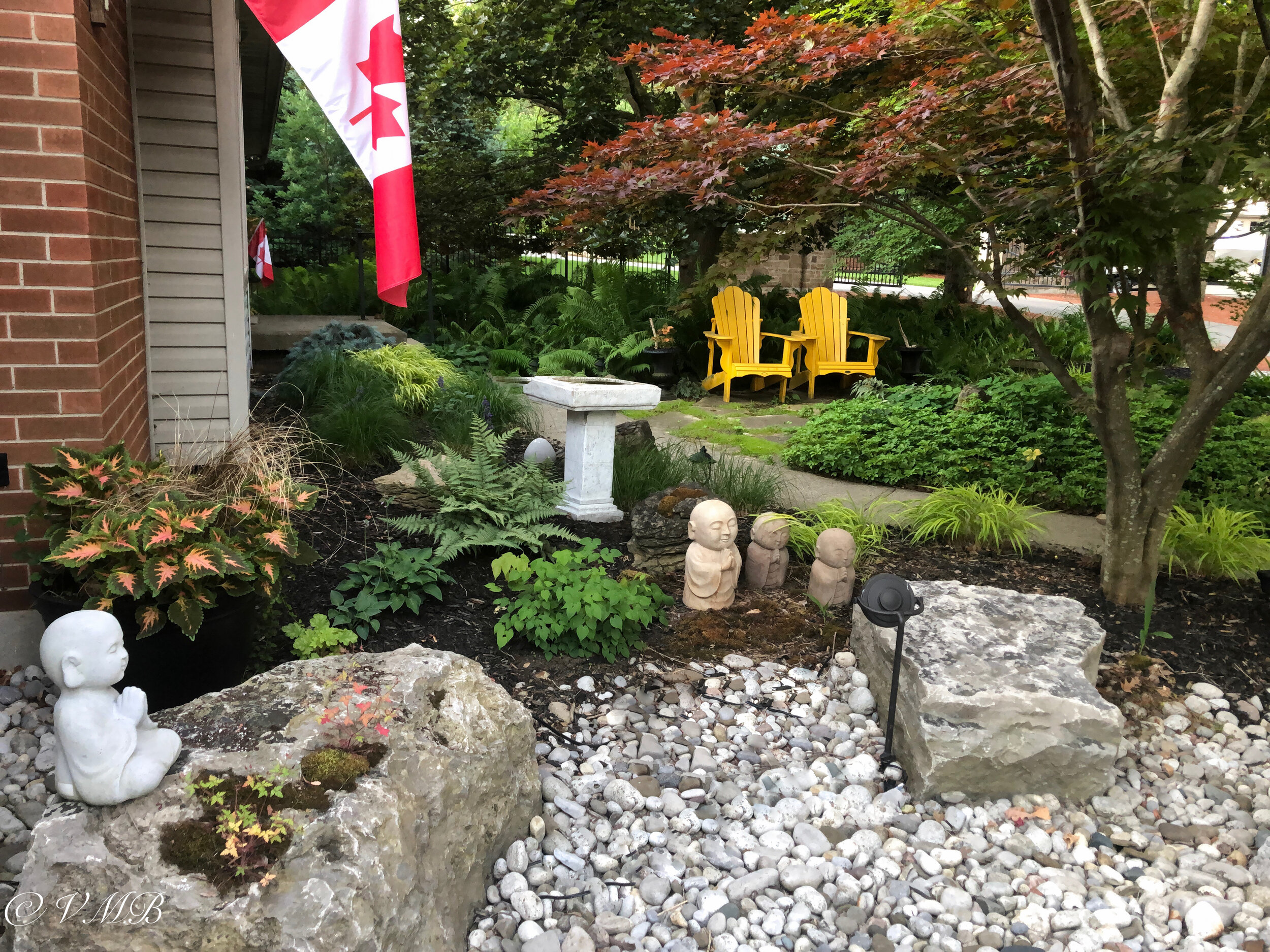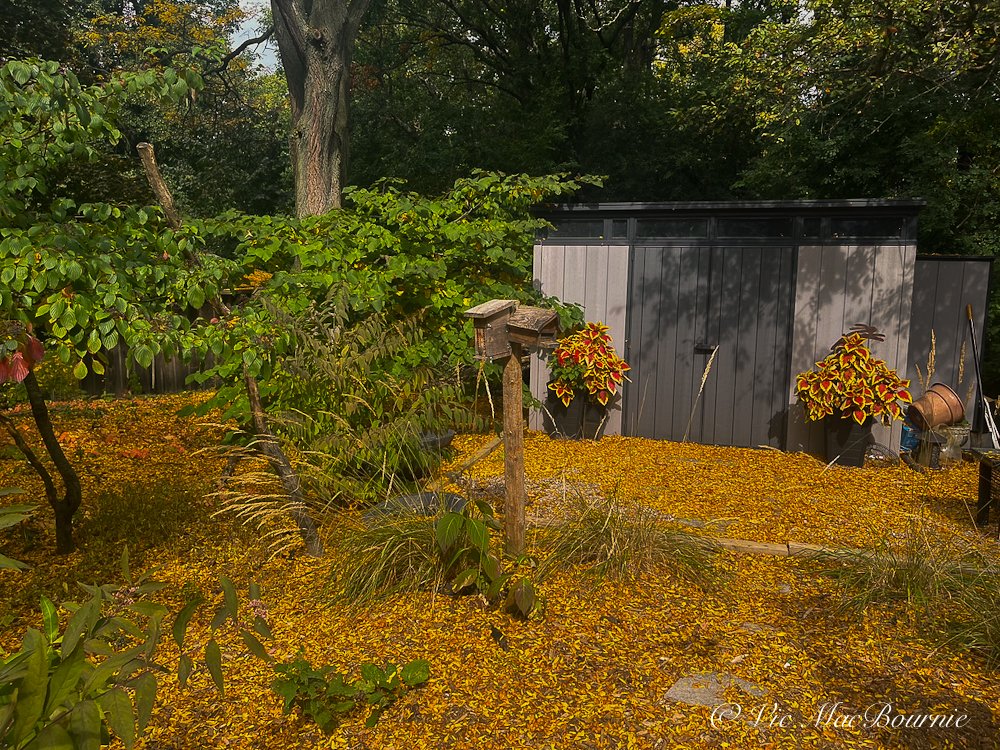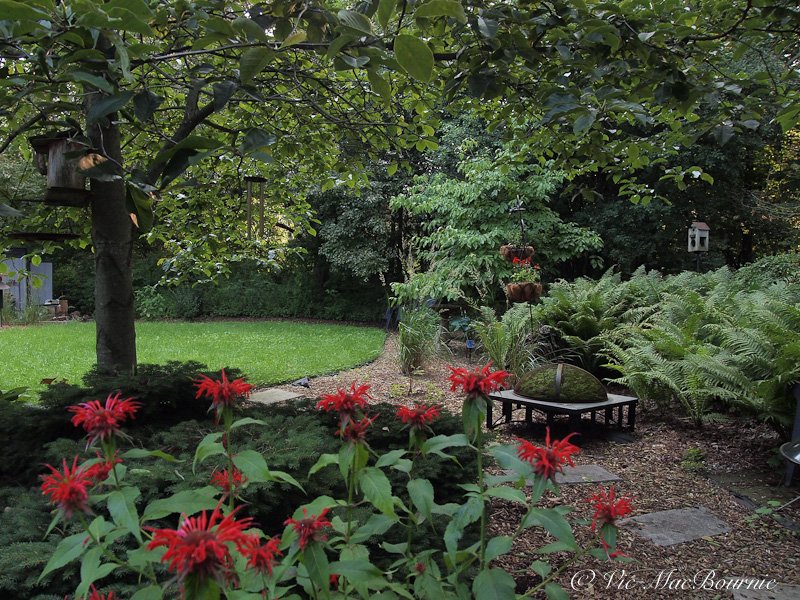Mulch: Organic vs Non-organic
The decision to use an organic vs a non-organic mulch is not always obvious. Here are some tips on when and how I use mulch in our woodland gardens .
How and when to use various types of mulch in the garden
Our garden gets by with four types of mulch. But only one is organic.
The organic mulch – mostly shredded cedar bark – is my primary go-to mulch that I have used in the garden since day 1. I can’t begin to even think how many truck loads of cedar mulch we have had dumped at the top of the driveway over the past twenty-plus years. Much of it is long gone, absorbed into the earth helping to make for a richer, more woodsy soil.
Other mulch selections in the garden include pea gravel, river rock, boulders and a red aggregate that I use as a driveway rather than asphalt or concrete. The aggregate is not only pleasing to look at, but more importantly, it allows water from rains or snow cover to seep into the ground and feed the roots of our trees rather than running down the driveway, onto the street and into the already overburdened sewer systems.
The garden’s design will often dictate when and what type of mulch to use.
A woodland garden benefits from shredded bark that looks natural and decomposes over time enriching the earth.
But there is room for other types of organic mulch, including pine needles (a favourite in the United States), cacao hulls and, of course, compost. Cacao is a great mulch to use in small quantities near a front door or a patio so you can take in the rich chocolate smell the mulch gives off.
Looking down on an island of black mondo grass planted in a dry river path to break up stone and give it a more natural look. (also see below)
5 uses for organic mulch
1) Use as a substitute for a living ground cover (either for a short- or long-term solution)
2) Around individual plants to keep weeds out, moderate the temperature and water content of the soil
3) As a first step to cover large areas that will eventually become part of the natural garden
4) Together with black landscape fabric to eliminate weeds or grass to begin or revitalize an area in the garden
5) To create a natural pathway through your woodland landscape
5 uses for non-organic mulch
1) Use pea gravel and stepping stones for an inexpensive, yet pleasing pathway that is more formal than a shredded bark path
2) To create dry-creek beds as garden focal points or to deal with drainage problems
3) In service areas around the home where you have no intention of adding bedding plants (ex: around utility boxes)
4) Consider converting an old asphalt driveway back to stone to eliminate water runoff and create a more textured, natural appearance.
5) Around your home’s foundation to encourage better drainage
Our garden’s organic mulch has not all been cedar. When one of the neighbours cut down a massive spruce tree on their front lawn several years ago, I asked the tree company workers if they would drop the entire tree on our driveway when they had finished shredding it. They were happy to oblige, but warned me that it would create a very acidic soil when it broke down.
It sat at the top of the driveway for a few weeks that fall and literally burned itself up as it began to decompose. I remember finally going out to move it onto the garden on a cool morning and it was so hot that every shovel full created enough steam that it appeared to be on fire.
I think I put about six inches of mulch down the side of the driveway that year.
I could not argue with the price, but it was ugly stuff with bits of spruce needles mixed in with the still-sappy branches. The next spring I covered the whole thing with a thin layer of cedar mulch and proceeded to allow it all to break down. Today, you would be hard pressed to find much evidence of the spruce tree and the final result is not acidic soil.
Just recently we moved two dump trucks full of cedar mulch into the backyard as part of a major landscaping project to eliminate as much grass as possible and create new gardens.
It involved putting down a layer of landscaping fabric to cut off any light to the existing grass, followed by at least three inches of cedar mulch.
I am definitely not a fan of black landscape fabric, but I always use it, (or old newspapers) as a first step in a new landscape project.
A combination of all our mulches come together in this images. Large boulders combine with pea gravel, river rock, crushed red brick (driveway) and even a little cedar bark mulch to create this ground cover.
The landscape fabric is great for keeping weeds out and, more importantly, killing existing grass. Its major problem, however, is that it also blocks living organisms from moving through the different layers of soil. If you are trying to build a healthy, woodsy soil, black landscape fabric certainly does more harm than good, over the long term.
My plan is always to remove it over time as the weeds and grass die off. I would expect that it is ready to be removed one to three years after it was installed.
In the meantime, I usually begin cutting large planting holes in the fabric a year after installing it. By then most of the grass is dead and it’s safe to begin gardening as long as you are careful to cover the bare soil with a thick layer of mulch after planting.
This process not only eliminates the huge task of removing the turf, it also takes advantage of the decomposing turf and leaves behind a nice layer of top soil to begin gardening. Patience is the key obviously.
If a low-maintenance garden is your priority, by all means leave the fabric and continue to garden through it. While it lasts a long time, it will eventually break down in the soil and lose its effectiveness as a weed barrier.
When it comes to using non-organic forms of mulch, the black landscape fabric always remains in place.
These are usually areas that I have no intention of ever converting to a traditional garden, so the fabric’s main purpose is to ensure nothing grows up through it.
In fact, it’s not unusual for me to double it up just to ensure unwanted guests can never make an appearance. They usually do, eventually, but it can take years before the weeds begin to break through the fabric.
Non-organic mulch
Non-organic mulch, mostly pea gravel and river rock, play a major role in our gardens.
They are used extensively in both the front and back gardens bringing a cohesiveness to the entire space while serving as a natural bridge from the garden to the hardscaping areas located closer to the house.
Great effort is made to make them look as natural as possible. Too often, homeowners and some landscapers try to get “cute” with river rock. In a woodland or natural garden, surrounding a tree or a garden with river rocks positioned in a perfect circle just doesn’t work. It looks unnatural and would never occur in nature, so try to come up with a more natural approach.
A natural-looking dry river bed, for example, benefits from more than one size of river rock to help it take on a more natural appearance. Ideally, very large river rocks need to be set in place at strategic locations throughout the river bed to anchor the design. Then, a layer of medium-size river rock added as the base, followed by smaller river rock pushed out toward the edges and finally pea gravel in what would be the stream’s washout area.
Now you don’t have to go to such extremes every time you use pea gravel or river rocks in the landscape, but it helps to keep it as natural looking as possible.
Our dry-river-bed journey began by filling in a large gully in the front of the house after cars kept falling in while turning at the end of our cul-de-sac. By turning the drainage ditch into a dry river bed using mostly river rock along with some pea gravel to fill in the edges, the water that naturally flowed through the area in the spring and during heavy rainfall, is allowed to continue along its course under and through the river rocks. The dry river bed solved three problems: it eliminated an eyesore; cleaned up any standing water that hung around in the spring; and still allowed the water to flow through the drainage gully.
Since then, we have used river rock and pea gravel, as well as some large boulders, to crate a Japanese-inspired garden in a part of the front yard. The river rock and pea gravel continue down the side of our home and pick up again in the backyard where they are used extensively as both a dry river and pea gravel pathway leading to the patio.
Inorganic mulches like stone can be effective in the landscape if used with care. Try to soften the harsh look of stone by allowing plants to spill over the edges. At times, I will even plant right into the pea gravel to create an island of green in the sea of stone. Along the back path, I have a planting of black mondo grass growing in a small island of larger river rock that never fails to make me smile when I see it.
Elsewhere, grasses grow out from a dry river bed suggesting a small island in the creek bed.
Mulch Mania: Building a foundation for a low-maintenance garden
Building a solid foundation starts with your garden’s soil and there’s no better way to build a high-quality soil than to use mulch. Cedar mulch forms the foundation of our low-maintenance woodland garden. It’s benefits are too numerous to list but here’s a start.
A temporary alternative to natural ground cover
Good or bad, we all remember the gardens of our childhood.
I remember dry, barren earth that literally turned to sand when you held it in your hands. It was the 1960s and the only plants that grew in the front gardens were traditional purple iris.
Not that my parents didn’t try. They turned over the soil religiously revealing the darker damp soil for a few hours until the sun baked it again.
It’s hard to imagine a worse recipe for building high-quality, healthy soil. But they toiled on, sometimes adding peat moss or top soil. The ending was always the same. Dry, bleached and baked sandy soil.
The missing ingredient was, of course, mulch. I am sure it was available at that time, but it certainly wasn’t piled up in bags at every building supply, grocery and nursery store.
Today, cedar mulch is so common in our area, it’s hard to believe there are any cedar trees still standing.
Organic mulch is commonly made from bark or wood chippings, but it can also be made of grass clippings or pine needles (a popular choice in parts of the United States,) to name just a few.
Non-organic mulch is another option and another blog post but includes stone such as pea gravel, aggregates and man-made substances.
Cedar mulch is a forest byproduct made from the shredded wood of cedar trees. Compared to pine mulch, the inherent nature of cedar makes it a longer-lasting mulch in the garden.
The benefits of mulch far outweigh any argument for not using it. Not only is cedar mulch attractive, whether you choose natural-, black-, brown- or red-coloured, it has a pleasant smell for the first few weeks it is put down, helps unify the garden and better shows off the plant foliage.
Despite its obvious benefits, it’s still not unusual to see uncovered, baked earth on my daily walks, usually accompanied by the homeowners on their hands and knees pulling weeds or, God forbid, turning the soil over so they can enjoy a few hours of dark soil before the sun comes out to bake it beige again.
Mulch is the perfect backdrop for the foliage of this Pagoda dogwood, while it protects and insulates the soil below. Over time it breaks down and adds a woodsy organic material to the soil.
In many ways, mulch actually takes the place of a living ground cover.
And, although bark mulch is a great beginning to amending your soil an creating a more woodsy soild, it’s best not to consider it the finished product.
In a woodland garden, a native and natural ground cover such as wild geraniums, bunchberry or ferns are a more desirable alternative than organic mulch, but there are plenty of situations where a ground cover is not feasible at the time.
That’s where an organic mulch truly shines.
Without going into all the benefits of heavily mulching your gardens, let’s examine just a few of the reasons mulch should be high on your list when you are building your Woodland garden.
Water retention: By shading the soil with a thick layer of mulch (ideally 3 inches or more), evaporation, both from the sun and wind, is minimized.
It also helps to regulate the temperature of the soil further reducing water evaporation and giving the plants a layer of insulation that helps keep the plants’ roots cool in the summer and warm in winter.
It is important to note, however, that mulch can also act as a barrier that makes getting sufficient water to your plants’ roots more difficult. It is much more water-efficient to target the plants individually either through a drip system or by hand watering them individually.
Deep watering a plant by leaving the hose dripping at its roots for several hours will allow the water to dive deep into the ground rather than getting locked into the mulch layer or just licking the top inch of the soil.
If your garden is properly mulched, you need to water less often but when you do water, ensure you are deep watering and targeting the plants’ roots.
One of the often overlooked benefits of mulch is that it helps prevent water runoff by trapping the moisture and moving it slowly to the soil below.
During a major storm, for example, water that might traditionally just run off in one direction, flooding one area and leaving another area more or less dry, will be better constrained to the general area it fell on. The result, a more evenly irrigated garden that will retain the moisture much longer than barren earth – possibly days or even weeks.
Weed Inhibition: Everyone is striving for a low-maintenance garden. Mulch is the key ingredient to achieving that end. But, let’s not kid ourselves it can’t perform miracles, especially if it is spread too thinly over the soil.
We’ve all seen it. A layer of mulch so thin that you can see the soil through it. Using large pieces of bark rather than the shredded bark, is often the biggest culprit here.
Unlike the shredded mulch, or pine needles, the bark pieces are too large to properly cover the soil and the resulting gaps make it too easy for seeds to find their way to the soil. (If you really love the look of the larger bark pieces, consider using the shredded mulch as your primary covering and top dress with the larger pieces.)
if the ground is not covered properly, once the weed seeds germinate, pulling them out brings more soil to the surface and before you know it, your garden is covered in weeds.
The key is to block light from reaching the soil to keep the seeds from germinating.
Some seeds will germinate right in the mulch but without proper soil they are either not long-lived or easily removed because it is near impossible for them to get properly rooted in the bark medium.
Also, if you water your individual plants rather than a general watering of the entire garden, the weeds’ roots often eventually are starved of water and die off. This is especially true following a wet spring. Weeds from the previous year will sprout in the damp mulch left by snow cover, but as the mulch dries out, the seedling roots will often die off.
A common complaint against the use of cedar mulch in the garden is that it can deplete the amount of nitrogen in the soil. While this can be true, it is not something most homeowners should be worried about.
What is more worrying is the practise of piling mulch around trees and plants in a volcanic mound that is almost guaranteed to kill the plant over time.
I often see it done by unknowing city workers who like to pile mulch up the tree’s trunk as high as possible thinking they are conserving water. Do not fall into this trap. Roots of trees and plants do not benefit from mulch touching them in any way.
Keep the mulch away from the plants and, instead, create a bowl of mulch around the tree trunks or plants where the sides can hold the water or at least slow its runoff from around the plant or tree. The bowl should be larger according to the size of the tree or plant and can actually extend out to the drip line of a young tree or plant.

